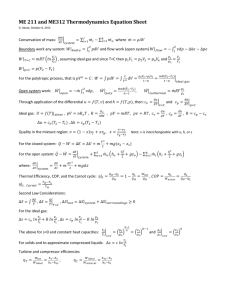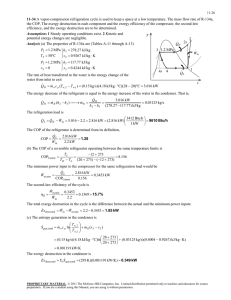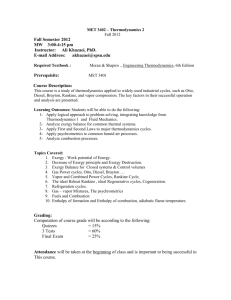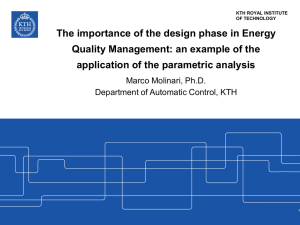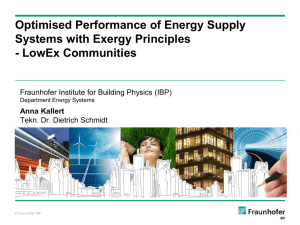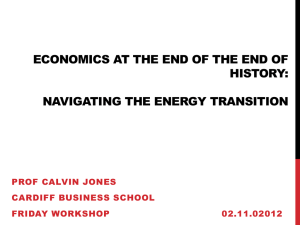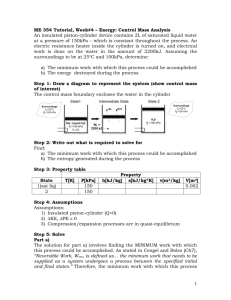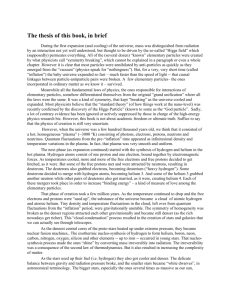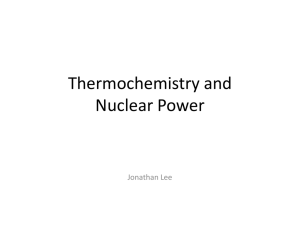Exergy
advertisement
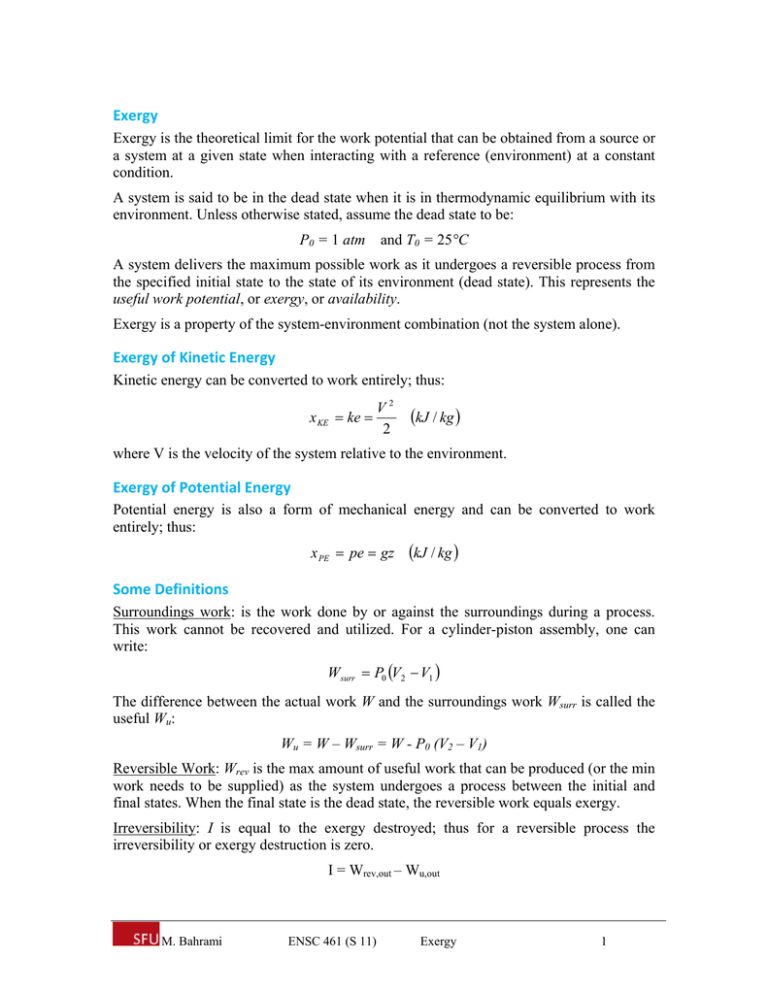
Exergy Exergy is the theoretical limit for the work potential that can be obtained from a source or a system at a given state when interacting with a reference (environment) at a constant condition. A system is said to be in the dead state when it is in thermodynamic equilibrium with its environment. Unless otherwise stated, assume the dead state to be: P0 = 1 atm and T0 = 25°C A system delivers the maximum possible work as it undergoes a reversible process from the specified initial state to the state of its environment (dead state). This represents the useful work potential, or exergy, or availability. Exergy is a property of the system-environment combination (not the system alone). Exergy of Kinetic Energy Kinetic energy can be converted to work entirely; thus: x KE V2 ke 2 kJ / kg where V is the velocity of the system relative to the environment. Exergy of Potential Energy Potential energy is also a form of mechanical energy and can be converted to work entirely; thus: x PE pe gz kJ / kg Some Definitions Surroundings work: is the work done by or against the surroundings during a process. This work cannot be recovered and utilized. For a cylinder-piston assembly, one can write: Wsurr P0 V2 V1 The difference between the actual work W and the surroundings work Wsurr is called the useful Wu: Wu = W – Wsurr = W - P0 (V2 – V1) Reversible Work: Wrev is the max amount of useful work that can be produced (or the min work needs to be supplied) as the system undergoes a process between the initial and final states. When the final state is the dead state, the reversible work equals exergy. Irreversibility: I is equal to the exergy destroyed; thus for a reversible process the irreversibility or exergy destruction is zero. I = Wrev,out – Wu,out M. Bahrami ENSC 461 (S 11) Exergy 1 or, I = Wu,in – Wrev,in Example 1 A 500-kg iron block is initially at 200°C and is allowed to cool to 27°C by transferring heat to the surroundings air at 27°C. Determine the reversible work and the irreversibility for this process. Assumption: 1) the kinetic potential energies are negligible. 2) the process involves no work interactions. Analysis: The reversible work is determined by considering a series of imaginary reversible heat engines operating between the source (at a variable temperature T) and the sink T0. Wrev th ,rev Qin 1 T0 T Wrev 1 0 T T T0 T Qin Qin Using the first law for the iron block, a relationship for the heat transfer can be found: Qout dU mc ave dT then Qin mc ave dT The reversible net work is determined to be: T0 T T Wrev 1 0 mc ave dT mc ave T1 T0 mc aveT0 ln 1 8191 kJ T T0 T1 Note that the first term in the above equation, mcave (T1 – T0) = 38,925 kJ, is the total heat transfer from the iron block to the engine. This means that only 21% of the heat transferred from the iron block could have been converted to work. The irreversibility for the process is determined from: I = Wrev – Wu = 8191 – 0 = 8191 kJ The entire work potential is wasted. The Second Law Efficiency The second law efficiency, ηII is the ratio of actual thermal efficiency to the maximum possible (reversible) thermal efficiency under the same conditions: M. Bahrami ENSC 461 (S 11) Exergy 2 II Exergy recovered Exergy destroyed 1 Exergy supplied Exergy supplied II th heat engines th ,rev II Wrev Work - consuming devices Wu II Wu Work - producing devices Wrev II COP refrigerators and heat pumps COPrev The second law efficiency serves as a measure of approximation to reversible operation; thus its value should range from 0 to 1. Ts,2 = 1100 K Ts,1 = 600 K Wnet,1 HEAT ENGINE 2 ηth = 35% HEAT ENGINE 1 ηth = 35% ηrev = 50% ηII = 70% Wnet,2 ηrev = 73% ηII = 48% Sink T = 300K Exergy of A Fixed Mass Consider a stationary cylinder-piston assembly that contains a fluid of mass m at T, P, U, and S. The system is allowed to undergo a differential change. The energy balance for the system during this differential process can be expressed as: Q W dU (1) The system involves some boundary work: W PdV P P0 dV P0 dV Wb ,useful P0 dV (2) For a system, which is at temperature T, to have a reversible heat transfer with the surroundings at T0, heat transfer must occur through a reversible heat engine (ηth = 1 – TL/TH). For the reversible heat engine, one can write: M. Bahrami ENSC 461 (S 11) Exergy 3 WHE 1 T T0 Q Q Q 0 T T For a reversible process, we have; dS Q WHE Q T0 dS Q WHE T0 dS T ; thus : 3 P P0 T T0 δWb, useful P0 δQ Heat engine δWHE T0 Using Eqs. (1), (2), and (3); one can find: Wtotal ,useful WHE Wb ,useful dU P0 dV T0 dS Integrating from initial state to dead state gives: Wtotal ,useful U U 0 P0 V V0 T0 S S 0 where Wtotal,useful is the total useful work delivered as the system undergoes a reversible process from the given state to the dead state which is the exergy of the system. Total exergy for a closed system including the potential and kinetic energies can be written as: V2 X U U 0 P0 V V0 T0 S S 0 m mgz 2 on a unit mass basis, the closed system exergy is : u - u 0 P0 v v0 T0 s s 0 V2 gz 2 where subscript 0 denotes the state of the system at the dead state. M. Bahrami ENSC 461 (S 11) Exergy 4 Exergy of a Flow Stream A flowing fluid has flow energy; that is the energy needed to maintain flow in a pipe or line; wflow = Pv The flow work is the boundary work done by a fluid on the fluid downstream. The exergy associated with flow energy can be written as xflow = PV – P0V = (P – P0) V The exergy of a flow stream can be found from: xflowing fluid = xnonflowing fluid + x flow xflowing fluid =(u – u0) + P0(V – V0) – T0(s – s0) + V2/2 +gz + (P - P0)V where V is the velocity of the system and V is the volume. xflowing fluid = (u + PV) – ( u0 – P0 V0) – T0(s – s0) + V2/2 +gz xflowing fluid = ψ = (h – h0) – T0(s – s0) + V2/2 +gz The flow exergy is represented by symbol ψ. Exergy by Heat Transfer Heat is a form of disorganized energy, thus only a portion of it can be converted to work. Heat transfer Q at a location at thermodynamic temperature T is accompanied by exergy transfer: T X heat 1 0 T Q kJ If the temperature of the heat source is changing with time, use: T X heat 1 0 T Q kJ Exergy Transfer by Work W Wsurr X work W for boundary work for other forms of work where Wsurr = P0 (V2 – V1). Therefore the exergy transfer with work such as shaft work and electrical work is equal to the work W. Note that the work done or against atmosphere is not available for any useful purpose, and should be excluded from available work. The Decrease of Exergy Principle Entropy and exergy for an isolated closed system can be related through an energy balance and entropy balance as follows: M. Bahrami ENSC 461 (S 11) Exergy 5 1) Energy balance: Ein – Eout = ∆E → 0 = E2 – E1 (1) 2) Entropy balance: Sin – Sout + Sgen = ∆Ssystem →Sgen = S2 – S1 (2) Multiplying Eq. (2) by T0 and subtracting it from Eq. (1), one finds: -T0 Sgen = E2 – E1 –T0 (S2 – S1) For a closed system, we know that: X 2 X 1 E 2 E1 P0 V2 V 1 T0 S 2 S 1 0 since V2 = V1 for an isolated system. Combining these two equations gives: - T0 Sgen = X2 – X1 ≤ 0 Since T0 is a positive value, we have: ∆Xisolated = (X2 – X1)isolated ≤ 0 The exergy of an isolated system during a process always decreases or, in the limiting case of a reversible process, remains constant. Irreversibilities such as friction, mixing, chemical reaction, heat transfer, unrestrained expansion always generate entropy (or destroy exergy). Xdestroyed = T0 Sgen ≥ 0 Exergy destruction cannot be negative. The decrease of exergy principle can also be expressed as: X destroyed 0 Irreversible process 0 Reversible process 0 Impossible process Exergy Balance: Closed System Xin – Xout – Xdestroyed = ∆Xsystem where; Xdestroyed = T0 Sgen For a closed system that does not involve any mass flow. The exergy balance can be written as: T0 Qk W P0 V2 V1 T0 S gen X 2 X 1 k 1 T or in the rate form: dV dX system T0 Q k W P0 system T0 S gen dt dt k 1 T M. Bahrami ENSC 461 (S 11) Exergy 6 Exergy Balance: Control Volumes Exergy balance relations for control volumes involve mass flow across the boundaries. The general exergy balance relationship can be expressed as: Xheat – Xwork + Xmass,in – Xmass,out – Xdestroyed = (X2 – X1)CV Or, T0 Qk W P0 V2 V1 m m X destroyed X 2 X 1 CV in out k 1 T in the rate form: T0 dV Qk W P0 CV dt k 1 T dX CV m m X destroyed dt in out where the initial and final states of the control volume are specified , the exergy change of the control volume is: X 2 X 1 m2 2 m11 Steady-flow devices such as: turbines, compressors, nozzles, diffusers, heat exchangers, pipes, and ducts do not experience no changes in their mass, energy, entropy, and exergy content as well as their volumes. Therefore: dVCV/dt = 0 and dXCV/dt = 0 Thus, one can write: T0 Qk W m m X destroyed 0 in out k 1 T M. Bahrami ENSC 461 (S 11) Exergy 7
